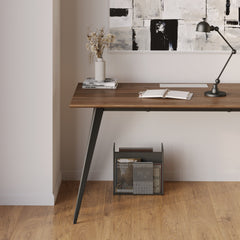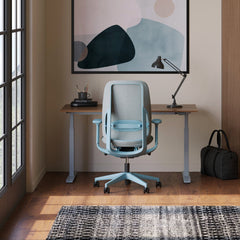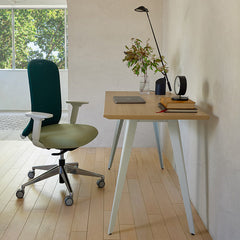Get 10% off your first order
Find the office furniture that’s designed to match your style, comfort, and needs perfectly. Subscribe
Spaces That Shift With You: Building a Workspace That Adapts to Every Task

Visit quiz page to see how we makes it easy to create an inspiring workplace

Workplace comfort is about more than posture. For individuals with allergies or chemical sensitivities, seating materials, adhesives, and trapped dust can quietly affect breathing, skin, and concentration. An allergy-safe office chair supports physical alignment while maintaining clean indoor air through breathable, low-emission materials. This comprehensive guide explores how careful material selection, ergonomic engineering, and smart workspace design protect sensitive users and foster a healthier office environment.

Foams, paints, and adhesives can release volatile organic compounds that remain trapped in recycled office air. Though invisible, these emissions may contribute to discomfort or mild respiratory symptoms in sensitive individuals. Safer construction uses low-VOC foams, water-based adhesives, and powder-coated metal to minimize exposure. When possible, request third-party verification of emissions levels.
Dense upholstery can trap dust and humidity. When heat and moisture accumulate, dust mites and bacteria thrive. Mesh or tightly woven microfibers resist buildup and maintain airflow. Choose fabrics that feel cool to the touch and resist static, which helps limit airborne dust.
A well-ventilated chair supports healthy air exchange. Curved backrests and perforated foam layers keep the body cooler and drier. Designs that maintain space between the back and frame prevent perspiration and odor. The breathable NOVO ergonomic model demonstrates how open mesh tensioning improves comfort while promoting fresh air circulation.
High-performing seating minimizes chemical exposure through transparent, safety-tested materials:
Water-based adhesives and finishes
Powder-coated frames with minimal solvent use
Low-VOC foams certified for indoor air quality
Verified material documentation and safety standards
For reference, work design guidance from CDC NIOSH emphasizes ergonomics as a core health protection measure, linking design decisions directly to employee wellness.
Breathable materials and ergonomic shapes allow heat to dissipate instead of trapping moisture. Mesh panels, ventilation channels, and suspended seat bases all improve air exchange. These designs are particularly helpful for individuals prone to skin irritation or overheating.
Upholstery that combines soft texture with non-allergenic fibers prevents irritation. The Muse chair with skin-friendly upholstery pairs comfort and airflow to reduce friction and maintain smooth contact even during long sitting periods.
The intersection of ergonomics and allergy management lies in body temperature and airflow. Proper lumbar and seat-depth adjustments keep posture neutral and reduce localized heat buildup. The Onyx chair for posture and airflow uses ventilated lumbar support to stabilize the spine while preventing trapped moisture.
Desk and chair pairing directly affect air movement. Desks with open frames and adjustable heights create better circulation and freedom of motion. The Urbanica desks that support ventilation maintain clean airflow beneath and behind the workspace for consistent comfort.
Subtle movement improves circulation and temperature control. Chairs that allow tilt and seat micro-shifts prevent static pressure points. This dynamic sitting style lowers heat and humidity, key factors in reducing allergen accumulation.
Even a breathable fabric can retain heat if its foam core lacks ventilation. Open-cell foam structures allow air to pass through the seat base, while suspension membranes distribute weight evenly. Testing for responsiveness—how quickly the foam recovers after compression—can reveal whether it traps heat or supports consistent airflow.
Antimicrobial finishes should be functional, not fragrant. Water-based coatings that resist bacteria without chemical perfumes or residues are ideal. Avoid glossy plasticized coatings that form a heat-retaining layer. Look for simple, specific descriptions of treatments instead of vague claims like “advanced protection technology.”
| Material Type | Airflow Efficiency | Chemical Sensitivity Risk | Cleaning Ease | Typical Use Case |
|---|---|---|---|---|
| Mesh polyester | Excellent | Low | Easy | Ergonomic task seating |
| Microfiber blend | Very good | Low to moderate | Easy | Everyday office seating |
| PU synthetic leather | Fair | Moderate | Easy | Executive looks, easy clean |
| Wool blend | Fair | Moderate | Delicate | Premium tactile feel |
| PVC vinyl | Poor | High | Easy | Budget seating |
| Recycled polyester | Very good | Low | Easy | Sustainable designs |
Chairs built with open frames and minimal seams collect less dust. The Seashell design in low-irritant mesh demonstrates a sculpted, breathable shell that balances flexibility with structural integrity ideal for long hours without heat retention.

Position seating so airflow is not blocked by walls, cabinets, or curtains. A 12–18 inch clearance behind the backrest improves circulation. Avoid placing chairs directly under vents that blow cold or dusty air, as this can cause skin dryness and irritation.
Consistent indoor humidity between 40–50 percent discourages dust mites and prevents static buildup. Moderate temperatures reduce perspiration, keeping seat surfaces dry and clean. Balanced environmental control helps preserve both comfort and fabric longevity.
Use a soft-brush vacuum with a HEPA filter on seat and backrest
Wipe armrests and controls with mild, fragrance-free cleaner
Check seams and joints where dust accumulates
Clean with a pH-balanced upholstery cleaner
Rinse microfiber or mesh gently with damp cloths and allow full drying
Inspect casters and chair bases to remove dust from moving parts
Always test cleaners on hidden areas. Avoid harsh disinfectants that can off-gas or leave residue. Allow chairs to air dry fully before extended sitting to prevent moisture entrapment within the foam or mesh.
Identify if symptoms arise from chemical sensitivity, dust exposure, or contact irritation. Track mild reactions during daily work. Recognizing whether issues occur immediately or gradually can help pinpoint whether fabric, foam, or environmental factors are responsible.
Whenever possible, test the chair physically. Sit, move, and observe temperature changes and odors. Avoid chairs with strong synthetic scents, sticky finishes, or unventilated padding.
Reliable manufacturers publish clear material details and emission certifications. Seek information about foam density, coating type, and fabric treatments. Transparent data reflects accountability and builds consumer trust.
Lumbar zones shaped for spinal alignment but open to air circulation
Mesh tension calibrated to maintain shape and support
Smooth perimeter edges that prevent dust collection
Waterfall front edges for even pressure distribution
Perforated or ventilated foam layers for cooling
Minimal bolstering to keep airflow unobstructed
Arm pads should stay cool and smooth. Avoid thick gel layers that trap heat. Firm, coated pads wipe clean easily and limit residue transfer from skin products.
Prefers open-mesh back and channel-cut foam to reduce dust. Relies on minimal seams for easy cleaning. Works best with moderate humidity control.
Needs soft, non-abrasive fabric and firm armrests that do not retain heat. Values smooth surfaces and fragrance-free finishes.
Seeks transparent material data, low-VOC certification, and water-based finishes. Uses HEPA filtration and weekly chair maintenance to sustain comfort.
Allow the chair to sit in a ventilated room after unboxing. Observe if any chemical odor dissipates within 24 hours. Persistent odors can indicate excessive solvent use.
Sit for an extended session while monitoring body temperature and fabric feel. A well-ventilated seat should remain cool and dry.
Test tilt and recline mechanisms. Ensure posture changes don’t restrict back ventilation or cause fabric creases that trap lint.
Apply a small amount of preferred cleaner on a hidden section to confirm compatibility and stain resistance before routine use.
In humid coastal cities, breathable mesh and open-cell foam prevent mildew. In arid climates, lightly textured microfibers reduce static and skin dryness. Local conditions determine whether moisture resistance or softness takes priority.
Different markets emphasize varying aesthetics. Some prefer sleek synthetic finishes, others lean toward natural textures. Regardless of style, health-focused manufacturing and low-emission materials are globally beneficial.
Sourcing regionally reduces transport emissions and supports local compliance with environmental standards. Transparent supply chains provide assurance for users prioritizing both health and sustainability.
Companies increasingly integrate wellness into workspace design. Ergonomic chairs that reduce allergic triggers enhance both comfort and performance. Furniture that respects the body’s interaction with air, light, and temperature has become a priority in modern workplaces.
New research focuses on plant-based foams, recycled fabrics, and modular components that are easier to clean or replace. Designers are refining mechanical ventilation within chair structures to maintain airflow without bulky fans or electronics.
The next generation of office furniture will treat air quality and ergonomics as inseparable. By choosing breathable, low-emission materials today, workplaces lay the groundwork for healthier, longer-lasting comfort for every employee.
Allergy-safe seating represents more than furniture selection it is an active choice for health-conscious design, air quality, and daily well-being. By combining thoughtful ergonomics, material transparency, and localized awareness, sensitive users can work in comfort without compromise.

Spaces That Shift With You: Building a Workspace That Adapts to Every Task

Room to Think: Designing an Efficient Workspace Without Overcrowding

Built to Support You: Why Ergonomic Tables Redefine Remote Work
Get 10% off your first order
Find the office furniture that’s designed to match your style, comfort, and needs perfectly. Subscribe
Leave a comment